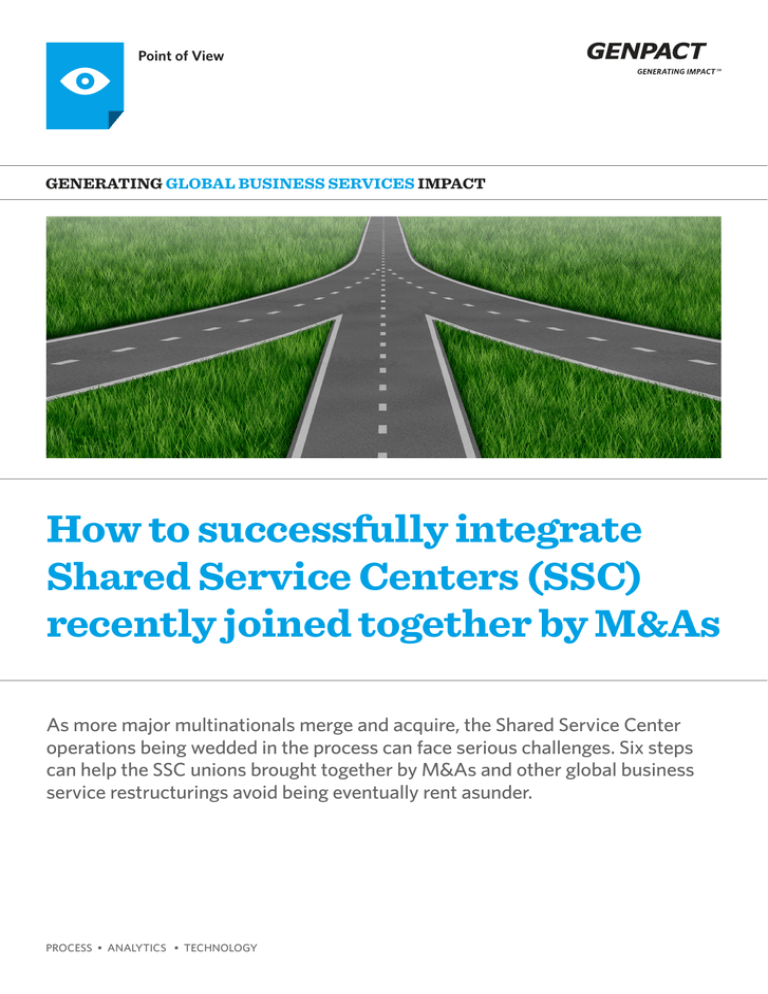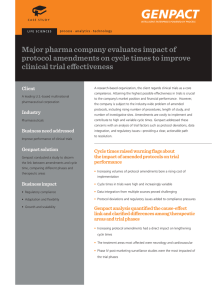
Point of View
Generating GLOBAL BUSINESS SERVICES Impact
How to successfully integrate
Shared Service Centers (SSC)
recently joined together by M&As
As more major multinationals merge and acquire, the Shared Service Center
operations being wedded in the process can face serious challenges. Six steps
can help the SSC unions brought together by M&As and other global business
service restructurings avoid being eventually rent asunder.
PROCESS • ANALYTICS • TECHNOLOGY
There’s a huge difference between flawlessly
planning and pulling off the perfect wedding and
actually doing the hard follow-up work necessary
to build a solid marriage, one in which the involved
parties are “one” in their commitment to “make
it work.” The same can be said of maintaining
the bonds that join an enterprise with the Shared
Service Center (SSC) operations that serve it.
Some post-M&A SSC staff integrations have been
hurriedly arranged with all the forethought of a
Step 1
Accept the
odds; then
commit to
beating them
together
Step 2
Start by
seeking
success in
places you
both know
you’re sure
to find it
Vegas wedding—with someone you met only the
night before. Of course, there’s no way to know for
sure if such a hurried beginning is destined to end
badly. And many is the regal wedding that took
months longer to plan than the marriage itself
lasted. However, whether the relationship is off
to a rocky start or has been on the rocks awhile,
six steps can repair the ties meant to bind the
SSC and the enterprise into a single, seamlessly
integrated operating entity.
Step 3
Step 4
Step 5
Step 6
Be ready
to reinvent
yourself
so as the
relationship
changes, you
can change
with it
Learn to
appreciate
what each
side can
give that the
other can’t
Show what
can be done
together that
neither of
you could do
alone
Communicate
the solution
and, through
leadership’s
example,
cement
acceptance
of it
Step 1: Accept the odds; then
commit to beating them together
The typical Shared Service Center relationship runs
three to five years. Not the best odds. As for beating
them, you can take a big first step by admitting
that all fairy-tale marriages are, well, fairy tales.
Every healthy real partnership—even (especially)
business ones—requires both sides to give at
least as much time, attention, and respect as they
get. Neither side can take the other for granted or
expect the other to tend to every problem singlehandedly. The relationship will last only if power
and responsibility are equitably shared, with both
sides agreeing to be “all in,” all the time.
Step 2: Start by seeking success in
places you both know you’re sure
to find it
Early in any SSC new relationship, there’s a stretch
when positive results are easily realized through
centralizing and consolidating common activities
and standardizing main processes. Inorganic
strategies such as M&A also add scope to the SSC,
often giving additional opportunities to create
synergies. The key at this stage is to seek success
where you’re most likely to find it. This will build
trust and confidence at a time when the new bonds
connecting each side to the other are still fragile.
GENPACT | Point of View
Step 3: Be ready to reinvent
yourself so as the relationship
changes, you can change with it
have metamorphosed from “backroom” to “core
business” overnight) can bring high hopes and
expectations to new employees.
In some cases, this means selling the captive SSC
operations or outsourcing their management to
a business process management/outsourcing
company. In all cases, creating a fully functional
“extended enterprise” among component
operations is a delicate undertaking. The success
or failure of such integrations depends heavily on
maintaining employee satisfaction. In a post-M&A
world, integration begins with new and former
leaders attempting to manage their rank-andfile employees’ first reactions. This situation can
easily turn negative if employees feel blindsided
by changes. Sometimes, employees from the
acquired company see change was necessary and
imminent due to flagging growth or missed targets.
More often, nondisclosure requirements governing
M&A activity for publicly traded companies will
mean almost all employees have to be kept in
the dark until the deal is done. In either case,
after years of loyal service and hard work, topperforming employees might take all the secrecy
as an indication that leadership did not trust them
enough to share, or that managers stayed mum
because they are planning to shunt the employees
aside at some point soon. If you hold tight to the
newlywed analogy, these employees are not unlike
children from a prior marriage. Suddenly they must
figure how to function as a “blended family” where
at first no one on either side sees itself as better,
and, in time, no employee sees the combined entity
as having “sides.”
Step 5: Show what can be done
together that neither of you could
do alone
Step 4: Learn to appreciate what
each side can give that the other
can’t
Third-party organizations often have many
new things to offer employees of the acquired
organization as a result of their scale, customer
focus, and commercial orientation. In our
experience, the possibilities for personal and
professional development, delegated ownership
lower in the organization, and career possibilities
within the new company (where your work may
Maximizing the opportunity available in the new
working environment will significantly improve
the satisfaction and commitment of the affected
employees. Hiring key new talent, bringing
them quickly into the organizational fold, and
demonstrating the value of that talent to veteran
employees will improve acceptance of change
enterprise-wide. Integrating key talent attained via
the recent merger/acquisition also ensures a more
open attitude to change and a greater willingness to
adapt to new ways of working.
Step 6: Communicate the solution
and, through leadership’s
example, cement acceptance of it
When attempting to communicate change, viewing
employees as a homogenous group is common
when, in fact, they are far more diverse than
leaders initially see. Thus, leaders and integration
teams should ensure as early as possible that they
understand the demographics and motivation of
all employee constituencies. Beyond explaining
what will happen with employees, senior leaders
must put themselves forth as examples of their
company’s values and culture. The example
GENPACT | Point of View
must show employees on the other side of the
integration what makes the company they joined
special, how they will be expected to treat its
customers, and important similarities between
cultures. Employees will go through many changes;
therefore, repeating resonant messages from
many angles helps. Steady exposure to several
inspirational leaders also helps “change things up”
yet stay “on message.”
When it comes to relationships, opposites
attract, and, just as frequently, complement each
other quite symbiotically. However, the new and
different can be as anxiety-inducing to some as it
is exhilarating to others. A clash between opposing
cultures can cause considerable frustration when
employees who are still relative strangers first
attempt to cooperate and collaborate. An initial
formal admission of cultural differences may
seem sufficient. It’s not. Realizing lasting success
means creating a combined integration team that
can provide more in-depth insight and ongoing
guidance about each side’s latent cultural behaviors
and habits. That may sound like a lot of extra work,
but when the goal is to form a more perfect union,
there is no substitute for doing the hard work.
This has been authored by Jan van Leeuwen, Eszter Vigh and Luc Mauvarin.
About Genpact
Genpact Limited (NYSE: G) is a global leader in transforming and running business processes and operations. We help clients become
more competitive by making their enterprises more intelligent: more adaptive, innovative, globally effective and connected. Genpact stands
for Generating Impact for hundreds of clients including over 100 of the Fortune Global 500. We offer an unbiased combination of smarter
processes, analytics and technology through our 64,000+ employees in 24 countries, with key management based in New York City. Behind
Genpact’s passion for process and operational excellence is the Lean and Six Sigma heritage of a former General Electric division that has
served GE businesses for 15+ years.
For more information, contact, gbs.solutions@genpact.com and visit, www.genpact.com/gbs
Follow Genpact on Twitter, Facebook and LinkedIn.
© 2014 Copyright Genpact. All Rights Reserved.






